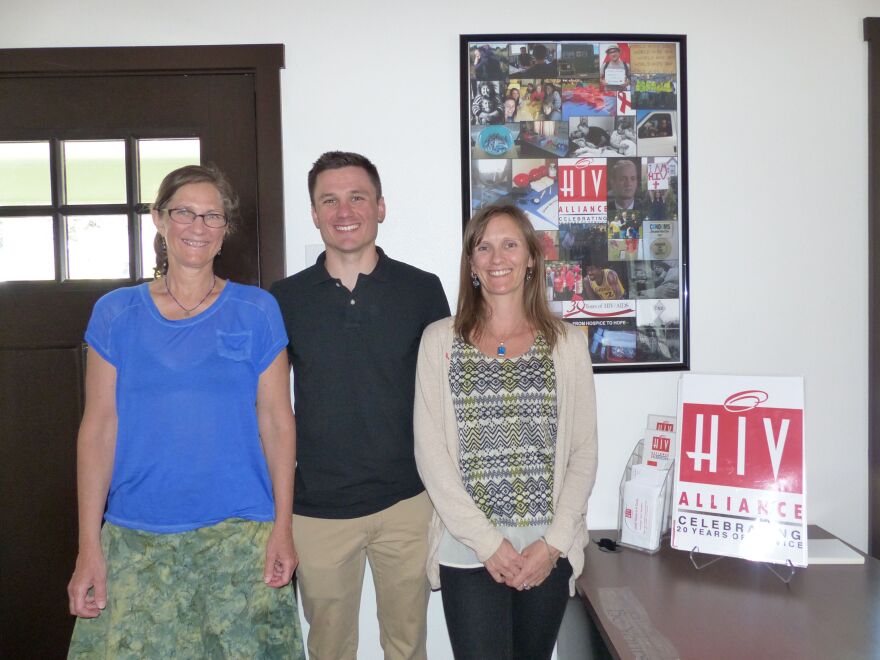About 5,500 Oregonians live with HIV/AIDS. A quarter of them reside in rural areas. Eugene-based HIV alliance is the only AIDS service organization helping patients in the eastern and southern parts of the state. The agency recently received a grant to fund a unique, telehealth project for HIV-positive people in remote places.
Far from the reaches of smog and city life, a man named Mark lives with his horses on a little farm outside Mount Angel. The 67 year old is a world traveler, a retired teacher with numerous degrees. And he lives with HIV.He was in the middle of teaching a class 4 years ago when his oncologist called.
Mark: “He said are you in a position where you can speak? And so I said to my students ‘just carry on.’ I stepped out in the hallway and he said, ‘I just want to tell you, you are HIV positive.’ He said, ‘It’s not something that’s going to take your life. You’re a strong person. So we just need to get on with it.”
Getting on with it meant beginning treatment.
Mark found some financial assistance for medication through a non-profit. Then the challenge became getting from his rural home to numerous doctors’ appointments and consultations. He heard about HIV Alliance. Director Renee Yandel says her agency had become acutely aware of the plight of rural HIV patients.
Yandel: “People had to travel literally hours, hundreds of miles to simply pick up medications that were life sustaining. To see physicians for things like small adjustments to medications. For a person living with HIV it’s a daily job to take care of your health. And if you don’t you’ll experience significant health decline.”
HIV Alliance serves a large geographic area--11 counties-- where Yandel says the majority of HIV positive clients live at or below the poverty level. She says rural patients have lots of issues that limit their access to care.

Tele-health programs are not new to HIV Alliance. Nurses and care coordinators have been using telephones and emails to support rural patients for years. What is new, and quite possibly the first of its kind, is a health care arrangement which allows pharmacists to collaborate electronically with HIV patients and their doctors.
Dr. Geoff L’Heureux is a pharmacist with an edge-- he knows the ins and outs of every drug prescribed to treat HIV/AIDS. And he can identify how those drugs might interact with other medicines. Very important.
L’Heureux: “Like everybody, people living with HIV have other health conditions that need to be addressed—so high cholesterol, diabetes, mental health. And HIV medications can interact with other medications. One of the biggest parts of my job is to make sure all the medications play nice and give the patient the best outcomes.”
Through the new telehealth project, 30 to 50 patients will use computer tablets to connect with the HIV Alliance pharmacist.
[sounds of computer tablet connection, pharmacist and patient talking]

L’Heureux:12 “Being able to look someone, at least virtually, eye to eye, really ups the level of rapport and comfort a patient can have with their provider.”
HIV is a specialty practice. The Alliance’s rural HIV telehealth project allows L’Heureux to prescribe or change meds and order labs. He says that can take a load off of small-town doctors who might not be familiar with HIV medications.
L’Heureux: “The drugs can have a lot of interactions and if not used appropriately not only do they not suppress the virus but can even be toxic.”
L’Heureux tells a story of a bad medication interaction *averted. One of his HIV patients found out he has cancer. After researching the treatment plan, the pharmacist made a life-saving discovery.
L’Heureux: “The chemotherapy the patient was going to be prescribed has a life time ceiling dose. He can only have so much before it has permanent damage to his heart and his HIV medication would have doubled the concentration of that.”
Turns out, that patient is Mark in Mount Angel. Mark—not the pharmacist- disclosed this information. He was diagnosed with Kaposi’s sarcoma, a cancer known to HIV patients.

Mark:”You think of the 1980’s and the guys dying with the growths all over their faces, all over their bodies. And I had many friends who died like this. When I heard that I thought, ‘Oh my God, I’m relegated to this and I’ll be dragging this cross for 6 months and be dying.’
Mark says it was L’Heureux who reassured him this is not a death sentence. So much has changed for HIV patients. During their telehealth “visits,” Mark says the pharmacist motivates patients as much as he advises-- even when contacted at the crack of dawn.
Mark:“At 4 or 5 o’clock in the morning, I’ve researched something on the computer about conditions that I’m feeling. I’ve gotten on my iPhone and messaged Jeff—‘what do you think, what’s happening here.’ And by 6:15-6:30am, there’s an answer coming back.”
Mark is nearing his final chemo treatment while successfully keeping the HIV virus suppressed. A lifelong equestrian, Mark says taking care of the horses on his farm is his reason to get up every morning.
Mark: “You just need to pull up your bootstraps and go on.”

The Oregon Health Authority has funded the HIV Alliance pharmacy telehealth project for one year. The average life expectancy for a modern HIV patient is now over 70. With that in mind, the agency is committed to securing additional funding to continue serving rural patients like Mark for the long-run.





